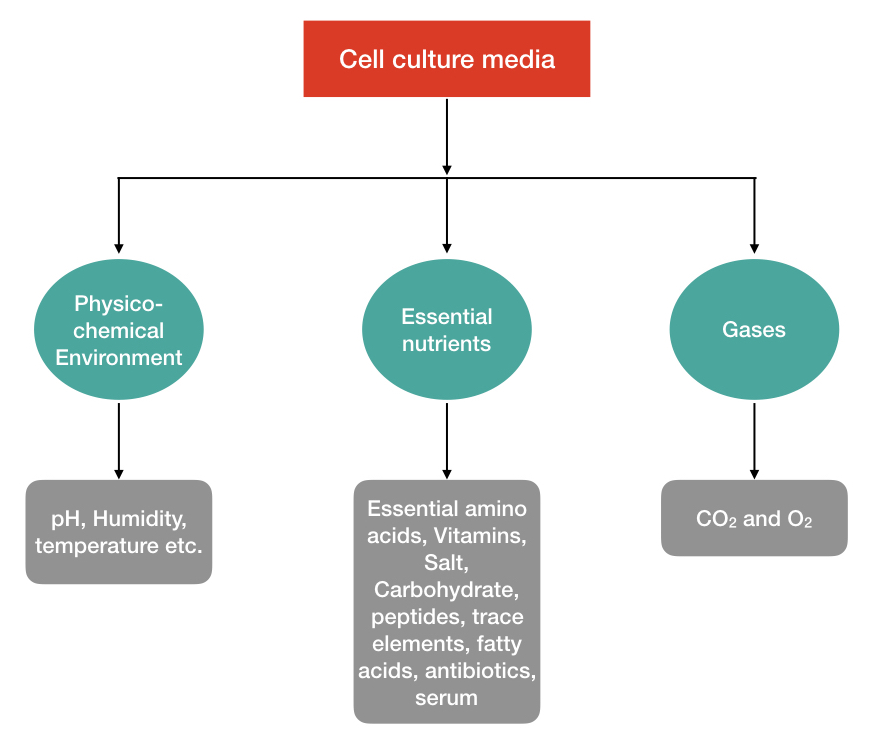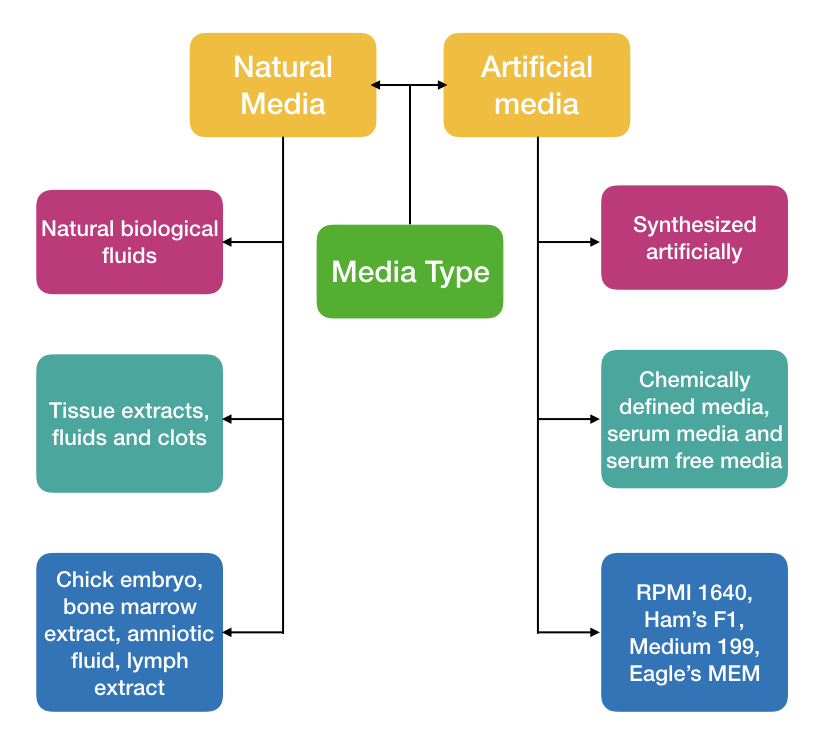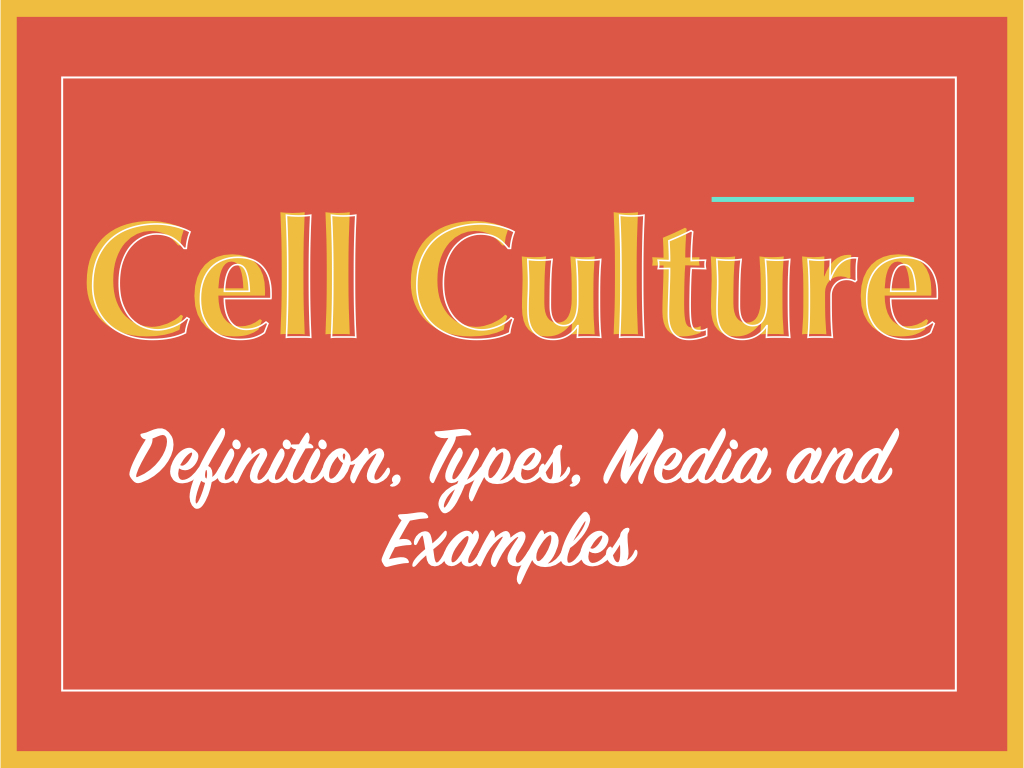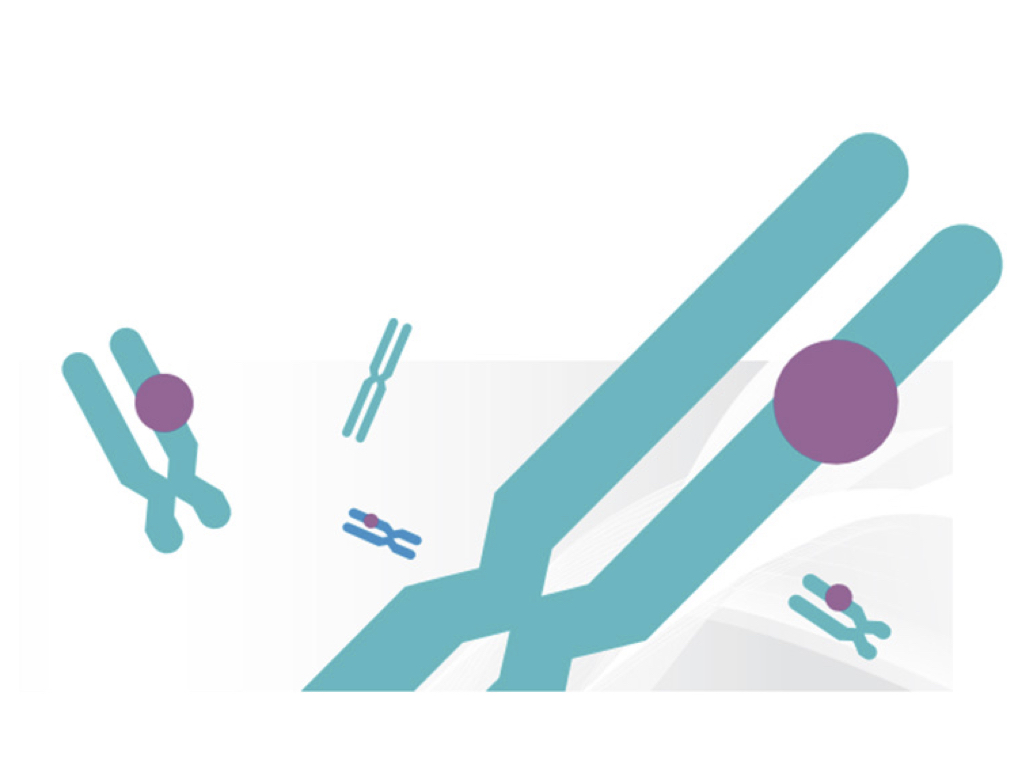“The cell culture media is a composition of nutrients like amino acids, carbohydrates, vitamins and other ingredients essential for the growth of cells in vitro.”
Culture allows scientists to learn more about cells and related things!
The cell culture is an aseptic condition to isolate cells followed by growing them artificially, in vitro processes using varied media is known as cell culture.
Present blog concentrate on the content related to karyotyping and cytogenetics. We are trying to explain every single detail, associated with karyotyping and try to explain it deeply.
Cell culture is a crucial step in karyotype analysis in which cells of target samples are culture in a scientific manner. However, only in cytogenetics, but also in separate cytology studies cell culture has prime importance.
Wonder, if we wish to study the function or structure of some cells, and how it behaves in different conditions, what we have to do! The answer is simple, we do have to isolate cells and grow artificially.
Growing cells artificially is known as “cell culture”, nonetheless, it is not as easy as the answer is! The process of cell culture is a specialized technique, and needs extra care, expertise and experience to perform.
Read more: What is the Karyotype used for?
Various cell types ranging from animal cells to plant and bacterial cells to fungal can be cultured, although media for culture vary. Applications of cell culture different among fields of study. Here are some,
- To investigate the physiology of cells
- To investigate cell biology and biochemistry
- To study mutagenesis and carcinogenesis
- To study the effects of drug, medicines and toxins
- To study gene expression and gene transfer
- To produce therapeutics and artificial proteins
Besides, it is also applying in other fields and study subjects as well. I know the introduction section is getting too long, but it is very important to understand the cell culture and its importance.
The cell culture technique is basically a part of microbiology, indeed, in which microbes are cultured regularly in order to study them. The idea of mammalian cell culture came from and techniques like karyotyping get involved.
Here we talk about cell culture in the present topic. We will also explain varied techniques of cell culture, cell culture media, composition, preparation and applications.
We will also try to explain the process of animal cell culture especially those we use in karyotyping. Let’s get started.
What is cell culture?
Before going ahead into the let us quickly go through some of the milestone discoveries in the field of cell culture. Note that here we are discussing cell culture not plant tissue culture, things that are discussed here are in context to mammalian or animal cell culture, not even microbial!
The first successful methodology to culture cells was performed by Ross Granville Harrison in 1910. Their in vitro technique was hanging drop.
In 1911, Montrose Burrows established the first “cell line*” using diluted blood plasma for the media. They also gave the name “tissue culture”.
1920, World’s first salt solutions were formulated to culture cells. However, to date to protect cultured cells, antibiotics weren’t used yet.
In 1940, Antibiotics were first applied in cell culture. Subsequently, in 1964, Klein smith and Pierce were cultured pluripotency of embryonic stem cells.
In 1965, Ham postulated, serum-free cloning of Chinese hamster cells.
Hober and Cohen had cultured Epidermal growth factor cells in 1967.
One of the milestones and key discoveries was made in 1975 when Kohler and Milstein discovered Hybridoma technology for monoclonal antibodies.
Definition:
An artificial process of growing cells under controlled conditions using artificial media in order to study the biological properties of cells or cell lines is referred to as cell culture.
Now moving to the next section explaining the requirements of the cell culture. Three key elements are required to culture cells viz essential nutrients, gases and controlled physio-chemical conditions.
Related article: What is Chromosomal Translocation?- Definition, Mechanism and Types.
Composition of cell culture:

Essential nutrients:
What do we need to grow normally? Or to grow any mammals? Proteins, carbohydrates and fat. Similar key ingredients are required here, either in original form or derived.
Essential nutrients such as carbohydrates, amino acids, vitamins, minerals, salts, hormones and growth factors should be present in the form of cell culture media.
Gases:
As we explained, much like essential nutrients gases such as CO2, O2, NO2 or any other should be present to perform metabolic activities during in vitro cell culture.
Physico-chemical environment:
Nutrients and gases can’t alone culture cells efficiently, pH, temperature, humidity and osmotic pressure play a decent role too. See, imagine, the in vitro growth process occurring inside our body, the same mechanism we need to mimic to culture cells.
The solutions or culture media should have a balanced pH, which means, use a balanced pH solution, use the temperature required to grow cells, which is commonly a body temperature, 37C.
Besides, yet another critical factor to success, cell culture is the aseptic condition- contamination-free zone, chemical and process.
Every cell culture instruments, chemicals, essentials, processes and practices should be performed under strict aseptic conditions. This point we will discuss somewhere in this article, moving ahead, to media composition of cell culture.
Steps in cell culture:
- Sample collection
- Isolating target cells
- Maintaining cells in a culture
- Choosing cell culture media- essential components
- Preventing contamination
- Cell harvesting
- Downstream applications
Read more: karyotyping- Step and procedure.
Cell culture media:
Media is key for cell culture. All karyotyping cell culture procedures are performed using various culture media for example the RPMI 1640 is a common choice for peripheral blood lymphocyte culture.
Technically, a culture media is a solution- a collection of varied nutrients, having essential ingredients and nutrients required to grow cells. In animal cell culture, there are two common types of cell culture that are used, or broadly divided into two categories; natural media or natural medium and artificial cell culture medium.
Natural Media:
Nature media is preliminarily applicable in animal cell cultures comprising naturally occurring biological fluids as a media such as tissue extracts, biological fluids and clots.
Look, to induce proliferation naturally, our biological fluids and tissue extracts are rich in nutrients and hence, are one of the most convenient and primary options.
Plasma, serum, plasma clots, chick embryo, liver/spleen/ tumor extract, amniotic fluids are the common sources to culture cells artificially. The broad category of natural media are;
Tissue extract– chick embryo, liver, spleen, leukocyte, bone marrow, bovine embryo and tumor extract.
Fluids– amniotic fluids, chorionic villi, lymph, placental cord serum, serum, lymph and plasma, etc.
Clots– Plasma clots and coagulants.
The advantage of natural media is easy availability and efficiency, however, on the downsides, natural media have poor reproducibility and varied composition. This means, not all the time, all the composition works efficiently. In addition, the concentration of every component isn’t known.
Significant limitations enlisted here replace natural media with an artificial one, which scientists use to culture cells nowadays.
Artificial media:
Artificial or synthetic media have great value over natural media. To differentiate varied cells, different culture media are now available which comprises those nutrients required to the specific cell types in exact concentration.
For example, the RPMI-1640 is one of the most trusted, common and widely used cell culture media to grow leukocytes for karyotyping.
Artificial media can be further divided into two categories: Basal media and complex media. Note that balanced salt solutions are also a kind of artificial media. PBS, HBSS, EBSS and DPBS are the common salt solutions.
Furthermore, It is categorized into serum-containing media, serum-free media, chemically defined media and protein-free media, each serving a different purpose.
| No | Element | Importance |
| 1 | Gases | Gases are required to induce basic cell activities |
| 2 | Amino acids | Induce cell proliferation and cell density, examples are- L-glutamine, |
| 3 | Inorganic salt | Provides calcium, potassium and sodium and balances the osmotic pressure. |
| 4 | Buffer system | Buffer system provides a constant environment for a cell to grow. |
| 5 | Vitamins | A can’t synthesize a sufficient amount of vitamins thus adding vitamins into a culture media helps in the growth and proliferation of cells. |
| 6 | HEPES | HEPES provide Zwitterion ions |
| 7 | Carbohydrates | Sugar or carbohydrate is the major energy source for cell culture. |
| 8 | Peptides and proteins | Proteins and peptides are binding agents that help to transport ingredients among cells. Albumin is the first choice for serum-free media. |
| 9 | Trace elements | To induce proper cell growth |
| 10 | Fatty acids | Ingradient of serum-free media helps cell proliferation as essential elements. |
| 11 | Antibiotics | To present contamination of bacteria and fungus. |
| 12 | Serum, if applicable | Provides various nutrients to culture. |
| 13 | Non-essential amino acids | Required for proper cell division. |
Serum-containing media:
The serum, traditionally, is an important ingredient of artificial cell culture media as it provides binding and other nutrients during the process. There are numerous advantages of using the serum in the media.
The serum is rich in hormones, growth factors and amino acids required for cell proliferation. In addition, as we said, it provides cell attachment to pass nutrients to adjacent cells and cell lines.
The serum is a great source of albumin which is one of the important ingredients. It also neutralizes topics and inhibitors.
The serum-containing media is a cheap and effective cell culture source, however, on the downside, some ingredients inhibit cell proliferation. Quality testing for every batch is required to get good results that is why serum media are usually not advised.
Serum-free media:
The serum-free media are simplified, better defined and nutrient-rich media that replace the serum media. This artificial media has an accurate composition of nutrients such as hormones, growth factors and nutrients which varied cell type.
In addition, it reduces the chance of contamination. Serum-free media are comparatively costlier.
Chemically defined media:
The chemically defined media are specialized ulta pure ingredient rich media required in some specialized applications only. These are costlier than serum-free media.
Protein free media:
Some cell culture applications require protein-free media; it inhibits the culture sometimes. Also, an additional purification step is required to remove proteins. Henceforth, cultures such as RPMI-1640 are protein-free.
(I know it’s huge, you don’t need to remember all things word to word, it is just some basic information one needs to know before learning the actual technique of cell culture or karyotyping).
Selective media vs differential media:
When a media is allowed to grow only a single type of cell is referred to as selective media. A single selective media isn’t useful for another cell type.
Contrary, when a media allows to grow different types of cells is referred to as differential media.
Differential media is useful for many cell types, however, it is more disadvantageous than the selective one. The selective media specifically designed only for a specific cell type and hence are more expensive.

Instruments required for cell culture:
Cell culture hood- laminar airflow or biosafety cabinet
The cell culture hood is a specialized cabinet that provides a constant sterile area to culture cells. It also has UV light and a HEPA filter too to remove microorganisms.
Waterbath:
- Water Bath is used to control the temperature of chemicals and culture.
Incubator- (CO2 and normal)
- A specialized instrument incubator is used to provide a constant environment to the cell culture. The CO2 incubator is used to provide CO2 in the culture.
Centrifuge:
- The centrifuge is used to separate phases or chemicals or cells.
Freeze and deep-freeze:
- Freeze and deep-freeze is used to store chemicals and culture media.
Microscope:
- Cells once cultured are investigated under the microscope.
Besides other requirements are Autoclave, cell counter, cell culture flask, petri dishes, microwell plates, waste containers, serological pipette, Gloves, media, sera, additives, 70% ethanol, aspirant pump and serological pipette.
Healthy cell culture practice:
Before preparing any cell culture experiment firstly, decontaminate, clean or sterile all the reagents, ingredients, instruments and area utilised to it.
- Use 70% alcohol to wash instruments and the benchtop of the culture hood. Also, wash hands with 70% alcohol.
- Wear gloves, mouth and head cap.
- Switch on the UV light of laminar airflow for a few minutes and allow it to sterile.
- Take all the ingredients and chemicals and allow them to thaw.
- Use sterile and autoclaved tips and pipettes and other glassware.
- Perform all procedures in sterile conditions.
- After cell culture carefully caps or close chemical and suspension bottles and put them back in the freeze or deep freeze.
Read more: 10 best karyotyping activities and assignments.
Examples of Cell culture media:
- Eagle’s MEM
- RPMI 1603
- RPMI 1640
- McCoy’s 5A
- Ham’s F1-
- Medium 199
- DME
Eagle’s MEM media:
The present media was developed by Harry Eagles in 1959 which is a type of Minimum Essential Media (MEM), and hence known as Eagle’s MEM media.
The present essential media comprises
- 6 salts: calcium potassium & sodium chloride, magnesium sulfate, sodium phosphate and sodium bicarbonate.
- 8 vitamins:
- 13 essential amino acids
- And other hidden ingredients
The present media is the first choice for human HeLa cells and mouse L cells. Moreover, BHK-21, HEP-2, MCF-7, fibroblasts, BHK-21, BHK-293 and primary rate astrocytes can also be cultured.
Ham’s F-10:
The present media was developed by R. G. Ham in 1962. It was the updated version of the previous F 7 media, and was first used to culture the Chinese hamster Ovary cells.
Often known as F 10 is a serum-free media used to culture Chinese Hamster Ovary, rat astrocytes, prostate epithelial cells, COS-& and varied other mammalian cells.
Although it is a serum free-media, as per the requirements, it comes under low serum as well, key highlights of the present media is low tryptophan and proline and higher arginine.
McCoy’s 5A:
The present media was first formulated by Neuman and McCoy in 1958 used to culture Novikoff hepatoma cells, and Carcinosarcoma 256 cells.
Primary cells of bone marrow, mouse kidney, skin, spleen, adrenal lands and gingiva are cultured using the present media. The present media is originally a modification of the basa media.
RPMI 1640 media:
In 1966, George E Moore, Robert E. Gerner and H. Addison had formulated the RPMI media, interestingly the name was given from the institute from where it was developed. The full name of RPMI is Roswell Park Memorial Institute.
It is the modified version of RPMI 1630 or McCoy’s 5A having the power to culture lymphocytes of blood. It is a serum-free media basically and rich in phosphate.
A typical pH of the present media is 8.0 and uses a bicarbonate buffering system. It is used to culture T- lymphocytes, B-lymphocytes, hybridoma cells and bone marrow cells.
The RPMI 1640 majorly contains Glucose, phenol red, Essential and non-essential amino acids and vitamins. Note that the present culture media is powerful enough to culture other cells such as carcinomas, astrocytes, MCF-7, HeLa, jurkat and PC12.
Medium 199:
The medium 199 is used widely for vaccine production, virology and cultivation of non-transformed cells. It was developed to culture chick embryo fibroblast culture.
Broad overview:
| Media | Cell type | Notes |
| Eagle’s MEM | HeLa, mouse L cells, BHK-21, HEP-2, MCF-7, fibroblasts, BHK-21, BHK-293 and primary rate astrocytes | |
| Ham’s F10 | Chinese Hamster Ovary, rat astrocytes, prostate epithelial cells, COS-& and varied other mammalian cells | |
| McCoy’s 5A | Primary cells of bone marrow, mouse kidney, skin, spleen, adrenal lands and gingiva | |
| RPMI 1640 | T- lymphocytes, B-lymphocytes, hybridoma cells and bone marrow cells | |
| Medium 199 | Vaccine production, virology and culture of non-transformed cells. |
Conclusion:
Here we have discussed things that are only related to animal/mammalian cell culture. Choosing the right culture media is yet another important criteria in order to get success that we will discuss in some other article. In addition, we will also illustrate “useful numbers for cell culture” in another article.
If you want to learn more on karyotyping and related topics, you can read in the search box and read it. We have written numerous articles on present topic on this blog.


